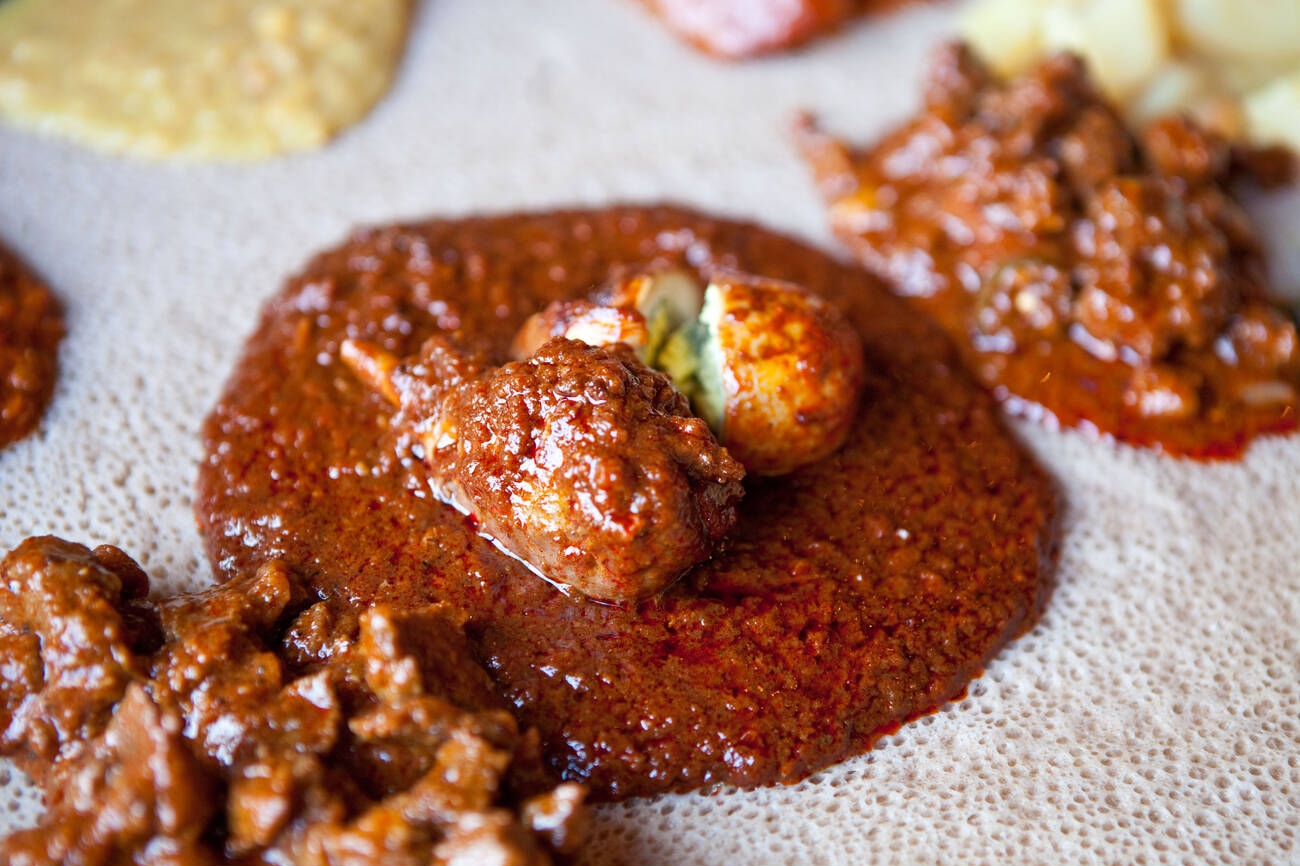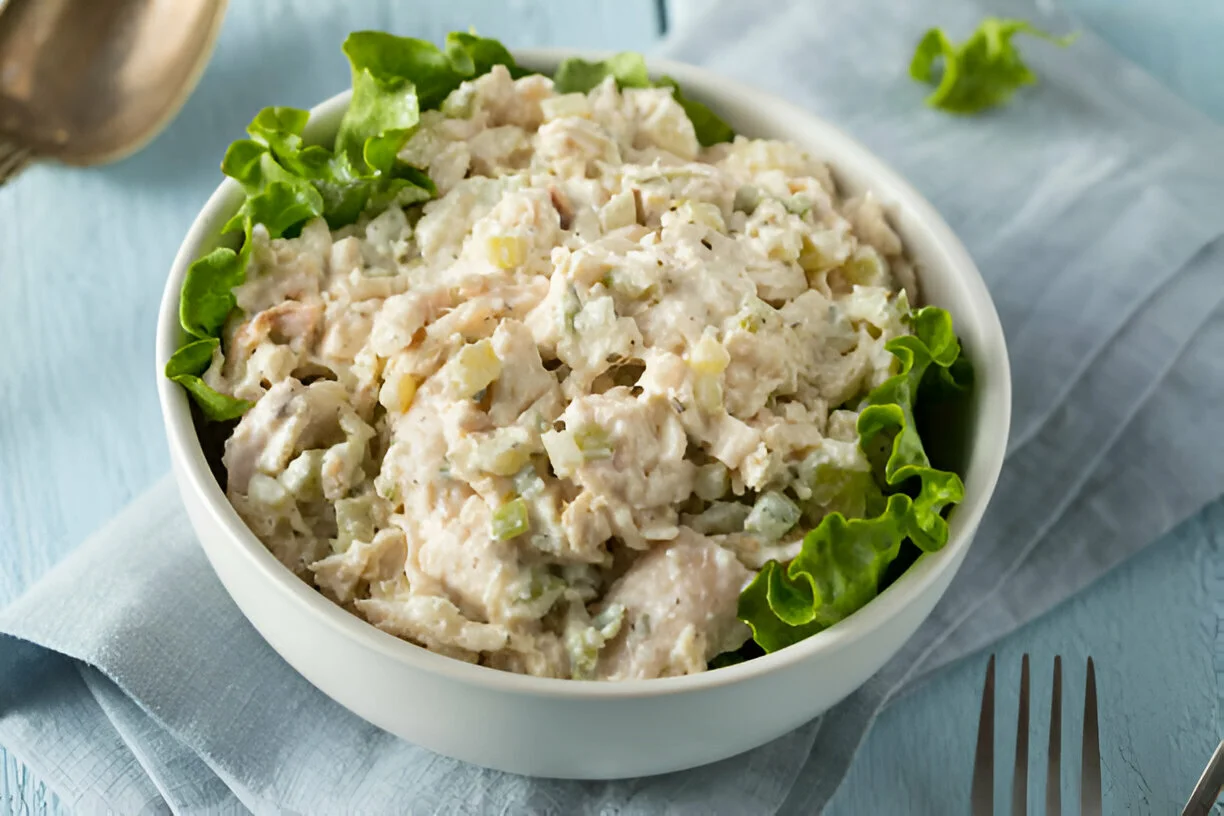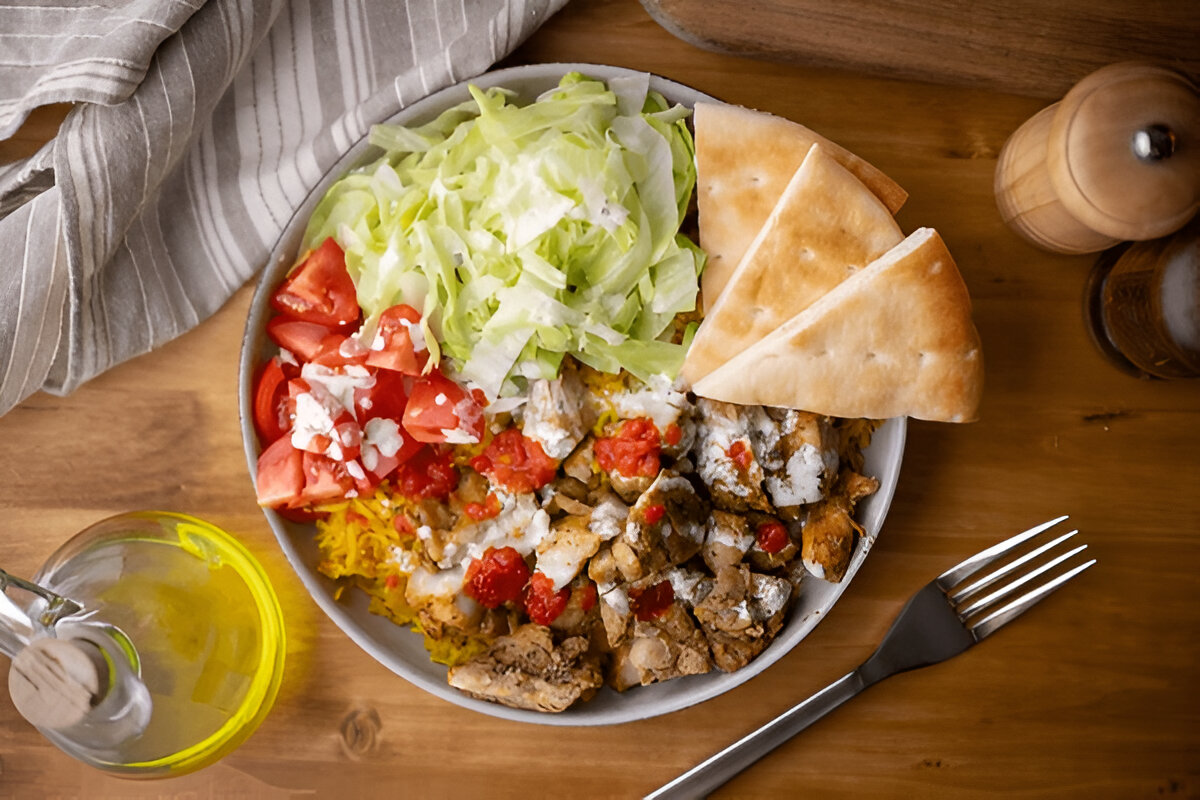When you think of Ethiopian food, there’s one dish that steals the spotlight every single time — Doro Wat.
This isn’t just some regular chicken stew. Nope. This is Ethiopia’s most treasured, slow-simmered, flavor-packed, fire-kissed national treasure. Ask anyone who’s tasted it, and they’ll tell you: Doro Wat isn’t just a meal. It’s an experience.
And yep, you’re about to make it. At home. No passport needed.
If you’ve been curious about Ethiopian food, if you’re wondering what is Doro Wat Ethiopian food, or if you’re just here because your search history looks like “how to make spicy Ethiopian chicken stew ASAP”… you’re exactly where you should be.
What Is Doro Wat?
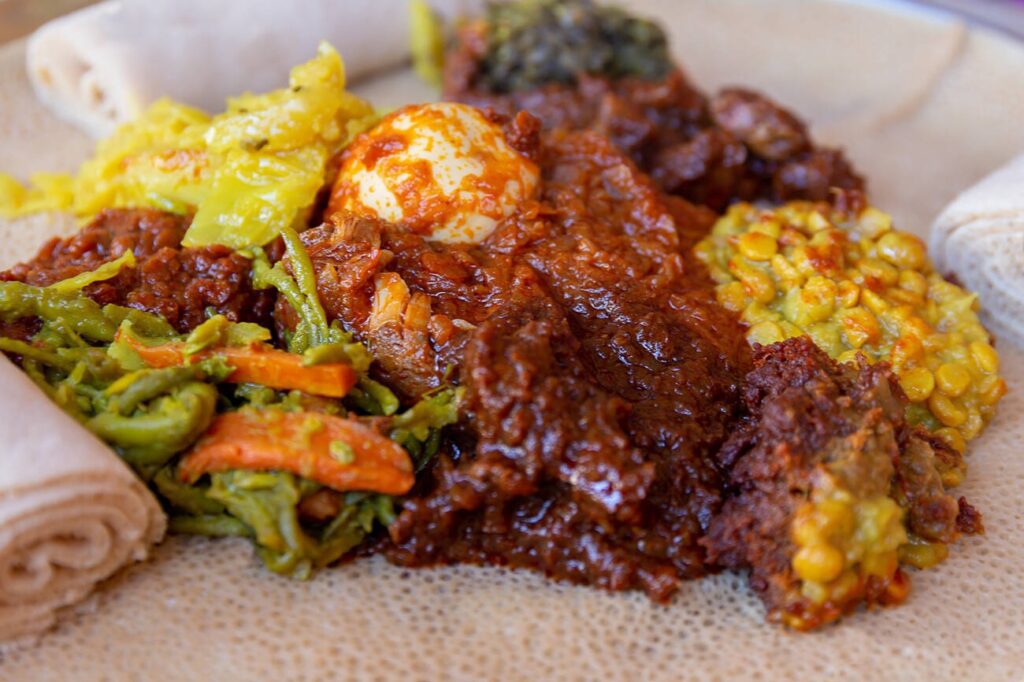
Doro Wat (some call it Doro Wot, others say Doro Wet) is a thick, spicy, slow-cooked chicken stew that’s eaten with injera — that big, tangy sourdough flatbread that also doubles as a utensil.
It’s made with berbere (a bold Ethiopian spice blend), niter kibbeh (a spiced clarified butter), slow-cooked onions, and tender chicken, and hard-boiled eggs. Always the eggs.
It’s a dish that’s been passed down, stirred with love, and loaded with history. If you’re eating Ethiopian traditional food, Doro Wat is probably on your plate.
Ask anyone from Addis Ababa to Bahir Dar, and they’ll tell you this is the stuff of holidays, birthdays, weddings, and straight-up comfort food on a random Tuesday.
Some say it’s spicy. Others say it’s soul-warming. Most just say: “More, please.”
Honestly, if injera doro wat isn’t involved, is it even a real traditional Ethiopian meal?
What Does Doro Mean in Ethiopian?
Quick language drop: “Doro” means chicken in Amharic (the most widely spoken language in Ethiopia). And “Wat” or “Wot” is the word for stew.
So yeah, Doro Wat = Chicken Stew. Simple name. Wildly deep flavor.
What Makes Doro Wat So Special?
It’s not just the spices. It’s not just the chicken. It’s how it all comes together.
- Onions — slow-cooked till they practically melt
- Berbere spice — fiery, earthy, and a little smoky
- Niter kibbeh — Ethiopian spiced butter that smells like heaven
- Chicken — bone-in for maximum flavor
- Hard-boiled eggs — they soak up the sauce like little flavor bombs
What really makes it sing is time. This isn’t a throw-it-in-a-pot-and-run dish. Doro Wat asks you to be present. To stir. To smell. To slow down. And yeah, that’s part of the experience.
Instant Pot Duo 7-in-1 Electric Pressure Cooker

Ethiopian Doro Wat Recipe
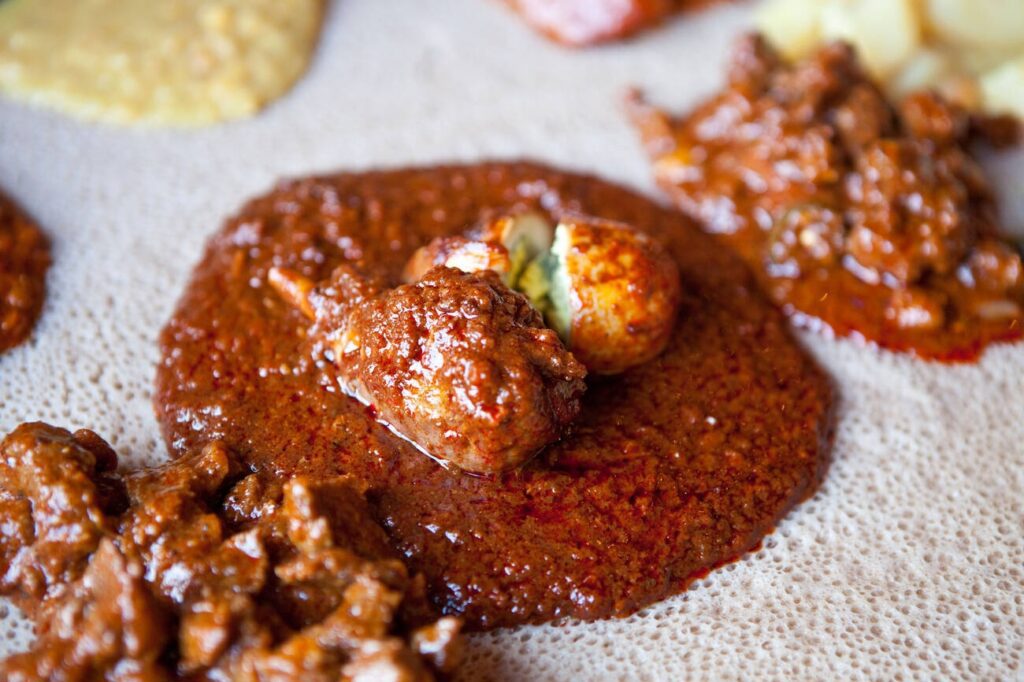
For the Chicken & Eggs
- 2.5 to 3 lbs chicken drumsticks or thighs (bone-in, skin removed)
- 2 tablespoons lemon juice
- 1½ teaspoons salt
- 1 teaspoon black pepper
- 6 large hard-boiled eggs (peeled and lightly scored)
For the Onion Base
- 4 large (about 6–7 cups) red onions, finely chopped
- 6 cloves garlic, minced
- 1 tablespoon fresh ginger, minced
- 4 tablespoons niter kibbeh (Ethiopian spiced clarified butter). Substitute: regular ghee or unsalted butter with a pinch of turmeric + cardamom
For the Sauce
- 4 tablespoons berbere spice mix (Adjust to taste: 3 for mild-medium, 5+ for spicy)
- 2 tablespoons tomato paste
- 1 tablespoon or 1 cube chicken bouillon powder or cube
- 1½ to 2 cups water or chicken broth (as needed)
- 2 tablespoons extra niter kibbeh or oil (optional, for finishing)
Instructions
Step 1: Prep the Chicken
- Rinse the chicken pieces in cold water with the lemon juice to remove any odor.
- Pat dry thoroughly with paper towels.
- Season lightly with salt and black pepper.
- Cover and set aside (you can marinate for 30 minutes if time allows).
Step 2: Caramelize the Onions
- Place the finely chopped onions in a dry pot (no oil yet!) over medium-low heat.
- Stir constantly for 30–40 minutes until onions turn soft, golden brown, and jammy. This step is critical — the slow cooking develops the depth of flavor. Don’t rush it!
- If they begin to stick, add a few splashes of water to loosen.
Step 3: Add the Spices
- Add niter kibbeh to the browned onions.
- Stir in garlic and ginger, sauté until fragrant (about 2–3 minutes).
- Add berbere spice and tomato paste. Mix well and cook for another 5 minutes. The mixture should darken slightly and become fragrant.
- If the mixture gets dry, add splashes of water or broth to keep it smooth.
Step 4: Simmer the Stew
- Add in your seasoned chicken pieces. Stir well to coat them in the spice-onion mixture.
- Add chicken bouillon and 1½ cups water or broth. The sauce should cover most of the chicken.
- Cover and simmer over low to medium heat for 45–50 minutes, or until chicken is tender and pulls away from the bone easily.

Step 5: Add the Eggs
- While the stew simmers, boil and peel your eggs.
- Make shallow slits around each egg with a knife so the sauce penetrates.
- After chicken is tender, gently add the hard-boiled eggs to the pot.
- Spoon sauce over eggs and simmer for 10–15 more minutes, uncovered. They’ll absorb all the flavor, like little golden sponges.
- Optional: Add a final spoon of niter kibbeh for richness.
Step 6: Serve the Doro Wat
- Let the stew rest for 10 minutes before serving.
- Traditionally served family-style over injera flatbread with other stews (like misir wat, shiro wat, or atkilt).
Notes
Low & slow wins – Don’t rush the onions or the simmer. That’s where the flavor builds.
Too thick? Add a splash of broth.
Too spicy? Mix in a spoon of plain yogurt or serve with ayib (Ethiopian cottage cheese).
Can’t find berbere? Try a blend of:
- 2 tsp paprika
- 1 tsp cayenne
- 1 tsp ground ginger
- ½ tsp cinnamon
- ½ tsp cardamom
- ½ tsp cloves
- ¼ tsp nutmeg
- ¼ tsp coriander
What to Serve With Doro Wat (Spoiler: It’s Injera)
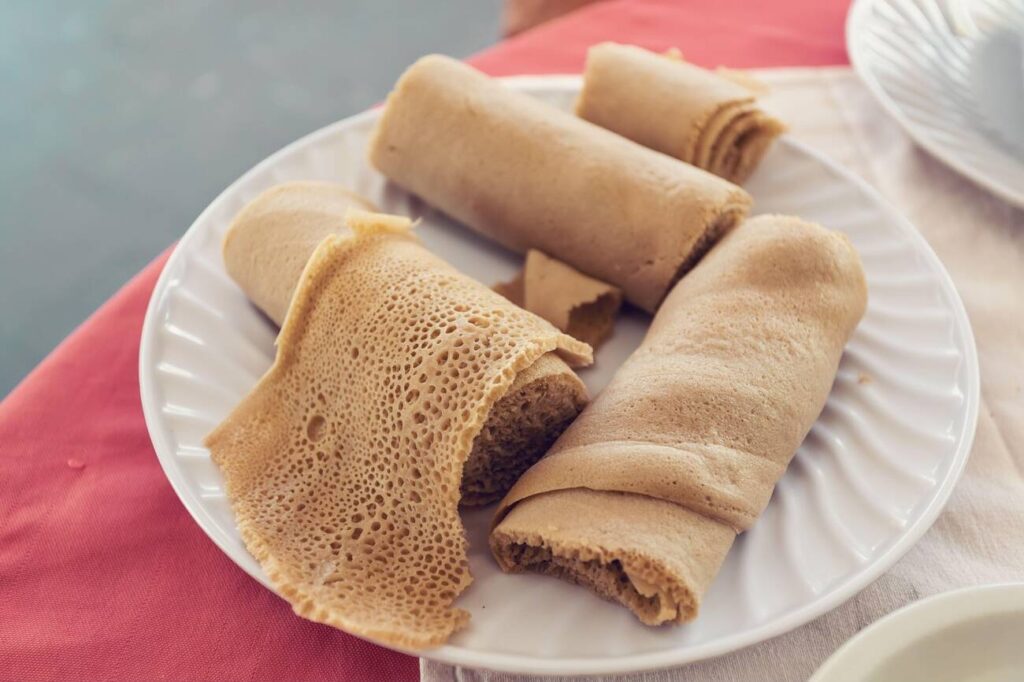
There’s no getting around it — injera is the must-have sidekick. It’s more than a bread. It’s the fork, the spoon, the plate, the napkin… and the star of Ethiopian food in Ethiopia.
Tear a piece, scoop up the stew, pop it in your mouth. No silverware. Just fingers, flavors, and joy.
Other things you might serve on the side:
- Shiro Wot – a smooth chickpea stew
- Atakilt Wat – cabbage, carrots, and potatoes in turmeric
- Fitfit – injera tossed with spices, sometimes leftover Doro Wat
- Red lentil Ethiopian recipe – like Misir Wat, spicy and smooth
How Do You Eat Doro Wat? The Traditional Way
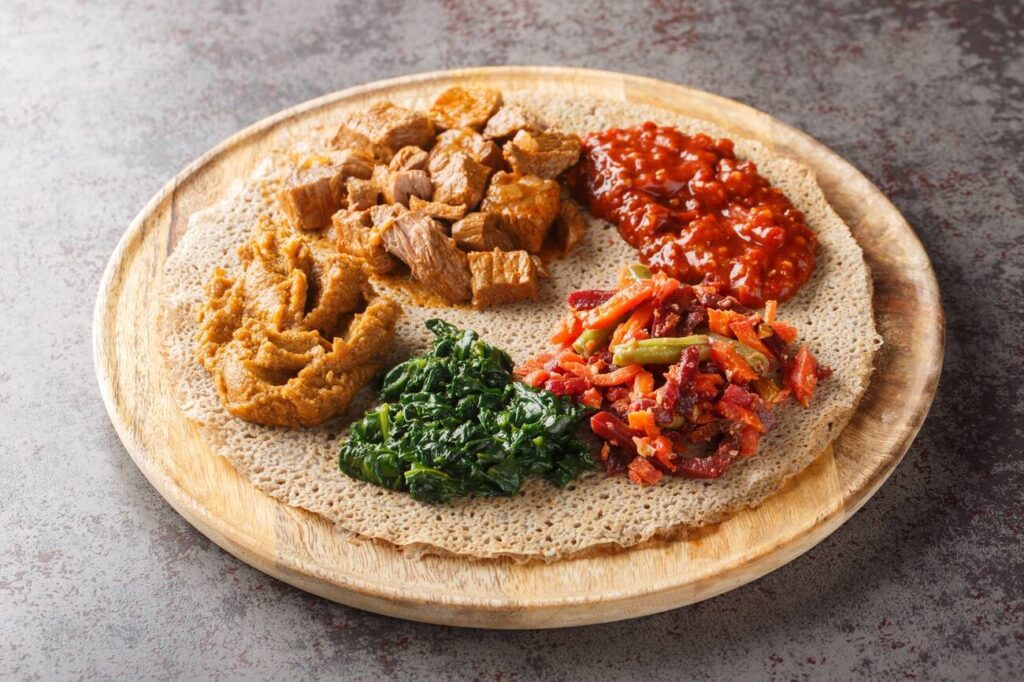
So, you’ve got a platter of injera laid out. You spoon a heap of doro wat right in the middle. Maybe a little shiro, a scoop of misir wat, some atkilt, a dollop of cottage cheese (ayib) for balance. It’s a party on a plate.
No forks. No knives. Just fingers. You tear off a piece of injera and scoop the stew. No double dipping rules here — it’s all communal. In fact, feeding each other a bite is considered a loving gesture.
This isn’t just eating. It’s an experience. A traditional Ethiopian meal is about sharing, tasting, and slowing down with good company.
Kibbeh Butter Recipe (If You Wanna Go Homemade)
Making niter kibbeh at home is easier than it sounds.
What you need
- 1 cup unsalted butter
- 1 tablespoon chopped garlic
- 1 tablespoon chopped ginger
- ½ teaspoon turmeric
- ½ teaspoon cardamom
- ¼ teaspoon cinnamon
- ¼ teaspoon fenugreek
- Pinch of nutmeg
- Pinch of cumin
Melt everything in a pan on low. Let it bubble gently, then strain the solids. What’s left? Liquid gold. That’s your kibbeh butter.
Common Mistakes to Avoid When Making Doro Wat
Let’s be real. Doro Wat isn’t the kind of dish you throw together in 15 minutes. It takes love, time, and attention. But it’s so worth it. To make sure yours turns out just right, here’s what folks often get wrong — and how to fix it.
Skipping the onion step
Caramelizing the onions slowly is the backbone of the stew. Don’t rush this step. Undercooked onions = flat flavor. Burned onions = bitter mess. You want soft, jammy, golden onions. Low heat. Stir often. Be patient.
Using raw spice instead of toasting it
Berbere needs a moment in the pot to bloom. Tossing it in at the end just makes the dish taste raw and dusty. Always let your berbere mingle with oil, onions, and garlic before adding broth or chicken.
Overcrowding the pot with chicken
Too much meat and not enough sauce? That’s how you end up with dry chicken. Give those pieces room to cook in the sauce and absorb the flavor properly.
Using regular butter instead of niter kibbeh
Sure, butter works in a pinch. But niter kibbeh adds depth that plain butter or oil just can’t replicate. If you can’t find it, try making your own at home (more on that below).
Adding eggs too soon
Boiled eggs go in toward the end. They’re already cooked, so they just need time to soak up that sauce, not disintegrate in it.
Storage & Leftover Pro Tips
Make-ahead
Doro Wat actually tastes better the next day. The spices deepen and the sauce gets richer. So if you’re planning for a dinner party or holiday spread, cook it the night before.
Fridge-friendly
Let it cool completely before storing. Transfer to an airtight container and keep it in the fridge for up to 5 days. Reheat on the stovetop over low heat with a splash of broth or water if needed.
Freezer hack
Yes, Doro Wat freezes beautifully. Portion it out into freezer-safe containers and it’ll last for up to 3 months. Thaw in the fridge overnight and reheat low and slow.
Don’t freeze with injera
Injera doesn’t thaw well — it goes rubbery. Always freeze it separately or better yet, buy it fresh when you’re ready to serve.
Meal-prep friendly? Absolutely.
Make a double batch of the sauce. Use half with chicken and eggs, and freeze the rest to pour over lentils, chickpeas, or even tofu during the week.
Other Ethiopian Dishes Recipes to Try After Doro Wat
If Doro Wat was your intro to Ethiopian food, good news — there’s a whole flavor world waiting for you. Here are some of the best Ethiopian dishes you’ve gotta try next.
Shiro Wot
A smooth, spicy chickpea stew. Protein-packed and simple but full of depth. Add onions, berbere, garlic, and shiro powder (ground chickpeas), and boom — dinner’s ready.
Misir Wot
Red lentils stewed in berbere and niter kibbeh. Vegan, filling, and classic in any Ethiopian food recipe book.
Fitfit
Ever had salad made from injera? That’s fitfit. Spiced, soaked bits of injera tossed with sauce or stew. Often made with leftovers — but tastes better than it sounds.
Atakilt Wat
Comfort food at its best. Cabbage, carrots, and potatoes simmered in turmeric and garlic. Mild, colorful, and great with anything spicy.
Ethiopian Desserts to Try After Doro Wat
Okay, truth time: Ethiopia isn’t known for ultra-sweet desserts like cake or donuts. But there are a few traditional treats worth noting.
Yetsom Beeyaynetu
Not really a dessert — more like a fasting platter with lentils and veggies — but sweet enough if you’re going light.
Traditional Ethiopian Coffee
Roasted, ground, and brewed right in front of you. Served with popcorn or sometimes a light cake. The coffee ceremony is the ultimate closer to an Ethiopian traditional food meal.
Where to Find Ethiopian Ingredients (or the Food Itself)
Can’t make it to Ethiopia? No worries. Here’s how to get your hands on the goods:
Online
- Amazon carries berbere, niter kibbeh, teff flour, and shiro powder.
- Websites like Brundo Ethiopian Spices and Mitmita.com have traditional spice blends straight from the source.
Local Options
- Check out Ethiopian markets, especially in cities like DC, LA, Seattle, or Atlanta.
- Search “Ethiopian cuisine near me” on Google Maps. You’d be surprised how many gems are hidden in plain sight.
Where to Find Ethiopian Cuisine Near Me?
Not lucky enough to have a local spot? Start with Google. Type Ethiopian cuisine near me, or try apps like Yelp, DoorDash, or Uber Eats.
Many cities across the U.S. now have amazing Ethiopian restaurants run by people who cook just like their grandmothers taught them.
If you’re ever near a place called Doro Ethiopian Restaurant, you already know what to order.
Ethiopian FAQs Time
A quick section to answer what folks are searching for when they hit Google with burning questions:
What is the national dish of Ethiopia?
Doro Wat. A rich, spicy chicken stew served with boiled eggs and injera. It’s the heart of most traditional Ethiopian meals.
What is Doro Wat exactly?
Doro Wat is a rich, spicy Ethiopian chicken stew made with caramelized onions, berbere spice, niter kibbeh (spiced butter), and hard-boiled eggs. It’s often served with injera, the tangy flatbread that’s iconic in Ethiopian food culture.
Is Doro Wat spicy?
Yes — but you control the heat! Berbere brings heat, but you can reduce the quantity if you’re spice-sensitive. Or mix in a bit of yogurt or ayib (Ethiopian-style soft cheese) on the side to mellow the fire.
Can I make it vegetarian?
You bet. Swap the chicken for firm tofu, mushrooms, or chickpeas. You can also use the base to make Misir Wat with lentils or Shiro Wat with ground chickpeas.
Where can I buy berbere spice?
Try African or Middle Eastern markets, or look online (brands like Brundo or Baro spice blends). Or make a quick version at home using paprika, cayenne, ginger, and warm spices like cinnamon and cardamom.
What’s the difference between Doro Wat and Doro Wot?
Just spelling. “Wat” and “Wot” are interchangeable — they both mean stew in Amharic. Some spell it Doro Wet, which is more phonetic. No matter how you spell it, it’s spicy chicken magic.
Is Doro Wat the national dish of Ethiopia?
Yes! It’s often served on holidays, birthdays, and major celebrations. It’s the heart and soul of Ethiopian traditional food, especially when served with injera.
Can I use rotisserie chicken to save time?
Technically yes, but you’ll miss out on the richness that comes from simmering raw chicken in the berbere sauce. Still, if you’re in a rush, shred pre-cooked chicken and simmer it in the sauce for at least 20 minutes.
What does “Doro” mean in Ethiopian?
Doro = chicken. Wat/Wot = stew. Simple as that. Doro Wat is literally “chicken stew.”
Final Thoughts on Ethiopian Food and Doro Wat
Trying Ethiopian food is not just about food. It’s about culture. History. Connection.
Whether you’re learning how to make doro wat recipe at home, exploring ethiopian food recipes online, or planning a trip to explore Ethiopian food in Ethiopia, this stew is your starting point.
It’s bold. It’s beautiful. It’s slow. And in a world of fast everything, that might just be the best thing about it.
So next time you’re wondering what is the national dish of Ethiopia, or you’re curious about the famous Ethiopian chicken dish, remember this: it’s Doro Wat.
Serve it hot. Eat it slow. Share it wide.
Print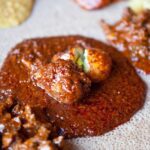
Ethiopian Doro Wat Recipe
Ingredients
For the Chicken & Eggs
-
2.5 to 3 lbs chicken drumsticks or thighs (bone-in, skin removed)
-
2 tablespoons lemon juice
-
1½ teaspoons salt
-
1 teaspoon black pepper
-
6 large hard-boiled eggs (peeled and lightly scored)
For the Onion Base
-
4 large (about 6–7 cups) red onions, finely chopped
-
6 cloves garlic, minced
-
1 tablespoon fresh ginger, minced
-
4 tablespoons niter kibbeh (Ethiopian spiced clarified butter). Substitute: regular ghee or unsalted butter with a pinch of turmeric + cardamom
For the Sauce
-
4 tablespoons berbere spice mix (Adjust to taste: 3 for mild-medium, 5+ for spicy)
-
2 tablespoons tomato paste
-
1 tablespoon or 1 cube chicken bouillon powder or cube
-
1½ to 2 cups water or chicken broth (as needed)
-
2 tablespoons extra niter kibbeh or oil (optional, for finishing)
Instructions
Step 1: Prep the Chicken
- Rinse the chicken pieces in cold water with the lemon juice to remove any odor.
- Pat dry thoroughly with paper towels.
- Season lightly with salt and black pepper.
- Cover and set aside (you can marinate for 30 minutes if time allows).
Step 2: Caramelize the Onions
- Place the finely chopped onions in a dry pot (no oil yet!) over medium-low heat.
- Stir constantly for 30–40 minutes until onions turn soft, golden brown, and jammy.
- This step is critical — the slow cooking develops the depth of flavor. Don’t rush it!
- If they begin to stick, add a few splashes of water to loosen.
Step 3: Add the Spices
- Add niter kibbeh to the browned onions.
- Stir in garlic and ginger, sauté until fragrant (about 2–3 minutes).
- Add berbere spice and tomato paste. Mix well and cook for another 5 minutes. The mixture should darken slightly and become fragrant.
- If the mixture gets dry, add splashes of water or broth to keep it smooth.
Step 4: Simmer the Stew
- Add in your seasoned chicken pieces. Stir well to coat them in the spice-onion mixture.
- Add chicken bouillon and 1½ cups water or broth. The sauce should cover most of the chicken.
- Cover and simmer over low to medium heat for 45–50 minutes, or until chicken is tender and pulls away from the bone easily.
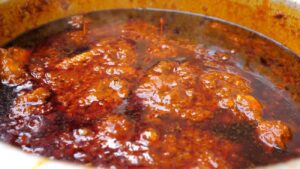
Step 5: Add the Eggs
- While the stew simmers, boil and peel your eggs.
- Make shallow slits around each egg with a knife so the sauce penetrates.
- After chicken is tender, gently add the hard-boiled eggs to the pot.
- Spoon sauce over eggs and simmer for 10–15 more minutes, uncovered. They’ll absorb all the flavor, like little golden sponges.
- Optional: Add a final spoon of niter kibbeh for richness.
Step 6: Serve the Doro Wat
- Let the stew rest for 10 minutes before serving.
- Traditionally served family-style over injera flatbread with other stews (like misir wat, shiro wat, or atkilt).
Notes
Low & slow wins – Don’t rush the onions or the simmer. That’s where the flavor builds.
Too thick? Add a splash of broth.
Too spicy? Mix in a spoon of plain yogurt or serve with ayib (Ethiopian cottage cheese).
Can’t find berbere? Try a blend of:
- 2 tsp paprika
- 1 tsp cayenne
- 1 tsp ground ginger
- ½ tsp cinnamon
- ½ tsp cardamom
- ½ tsp cloves
- ¼ tsp nutmeg
- ¼ tsp coriander
